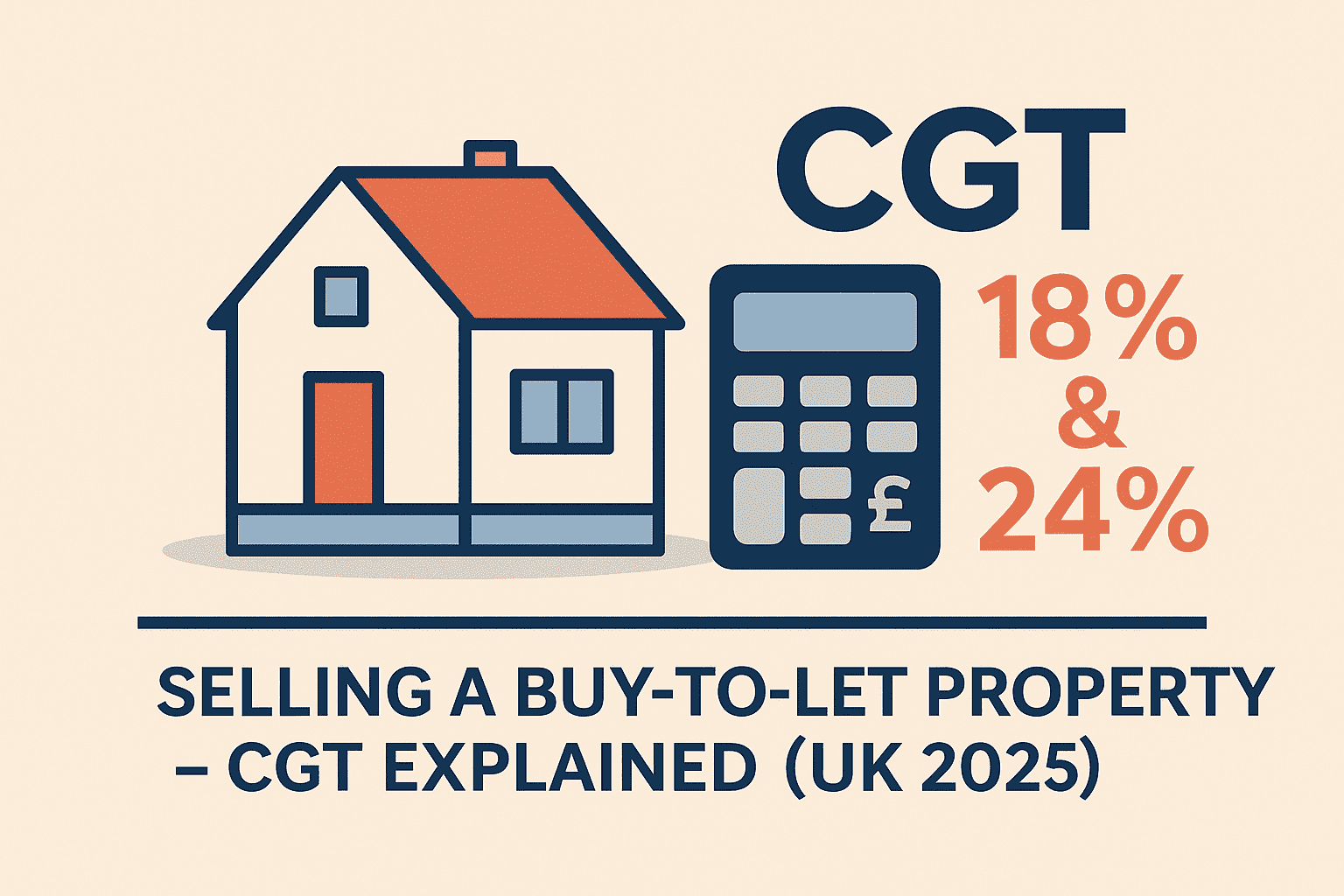Selling a rental property isn’t just about Estate-agent fees and completion dates — it’s about understanding Capital Gains Tax (CGT).
Many Landlords are surprised by how quickly CGT adds up when they sell or transfer a buy-to-let.
Here’s a clear breakdown of how the tax is calculated and what you can deduct.
📺 Watch: Selling a Buy-to-Let Property – CGT Explained (UK 2025)
When CGT Applies
You pay CGT when you Sell, Gift or Transfer a property that:
- Is not your main home, or
- Has been rented out at any point.
If you’re transferring a property to an ex-partner rather than selling it, the tax rules are different — see our guide on Transferring a Property After Separation: What Tax Applies When You’re Not Married
It’s the gain, not the sale price, that’s taxed — so your goal is to reduce that gain with every legitimate cost and relief available.
Step 1: Work Out the Gain
| Example figures | Amount |
| Sale price (March 2025) | £230,000 |
| Less purchase price (July 2010) | £150,000 |
| Initial gain | £80,000 |
Step 2: Deduct Allowable Costs
These reduce the taxable gain — not your income.
You can usually deduct:
- Estate agent and Solicitor fees
- Stamp Duty and legal costs from the original purchase
- Capital improvements (e.g. extensions, new kitchen)
- Professional fees directly related to sale or acquisition
| Deductible costs | Amount |
| Estate agent + Solicitor | £4,000 |
| Improvements (new kitchen, bathroom) | £12,000 |
| Stamp Duty on purchase | £3,000 |
| Total allowable costs | £19,000 |
Adjusted gain: £80,000 − £19,000 = £61,000
For a full list of what you can claim when selling, see our blog What Expenses Can You Claim When Selling a Rental Property? — it outlines which costs HMRC accepts and which are often disallowed.
Step 3: Apply Reliefs and Exemptions
- Annual CGT exemption: £3,000 (2025/26)
- Private Residence Relief (PRR): if you ever lived there as your home.
- Lettings Relief: only available in limited cases where PRR also applies.
If you lived in the property for three out of fifteen years, PRR could exempt that portion of the gain.
Example:
£61,000 × (3 years / 15 years) = £12,200 exempt under PRR
Remaining taxable gain = £48,800 − £3,000 (annual exemption) = £45,800
Step 4: Apply the Correct CGT Rate
Residential property gains are taxed at:
- 18% if you’re a basic-rate taxpayer, or
- 24% if any part of the gain pushes you into higher-rate territory.
For a higher-rate taxpayer:
£45,800 × 24% = £10,992 CGT payable
Step 5: Report and Pay Within 60 Days
HMRC requires UK residential property disposals to be reported and paid within 60 days of completion.
Miss the deadline and you’ll face penalties and interest.
Step 6: Keep Every Record
Keep:
- Completion statements
- Purchase and Sale contracts
- Invoices for improvements and professional fees
HMRC can ask for evidence up to six years after you file the return.
How to Reduce Future CGT
- Time sales across different tax years to use multiple exemptions
- Transfer part ownership to a Spouse before sale (if married)
- Track all improvement costs as you go
- Consider a Property Tax Review before committing to sell
Thinking of reinvesting the proceeds through a company? Our blog on Limited Company or Personal Name – Which Is Better for Rental Property in 2025 explains how the structure affects future tax and ownership.
Key Takeaways
- CGT applies to the gain, not the sale price
- Deduct allowable costs and improvements to reduce the gain
- Use your annual exemption and PRR where available
- Report within 60 days
- Keep full records — HMRC can check later
Need Help Calculating CGT on Your Property Sale?
A Property Tax Review can show exactly what’s taxable, which costs qualify, and how to plan your sale for the lowest liability.
Email info@gracecertifiedaccountants.com or book a clarity call to get started.
